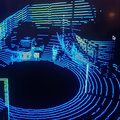 Hello Hack Chat!
Hello Hack Chat!
 Hi Chris - welcome!
Hi Chris - welcome!
 thanks!
thanks!
 oh heeeey
oh heeeey
 Hey Morgan
Hey Morgan
 Hi!
Hi!
 Looks like we've got a good turnout, so let's kick it off. Welcome to the Hack Chat everyone, thanks for coming, and thanks to Chris Gammell for hosting. When Chris suggested low-level analog measurement as a topic, I jumped at it - figured we'd all love to hear about that.
Looks like we've got a good turnout, so let's kick it off. Welcome to the Hack Chat everyone, thanks for coming, and thanks to Chris Gammell for hosting. When Chris suggested low-level analog measurement as a topic, I jumped at it - figured we'd all love to hear about that.
Take it away, Chris!
 OK!
OK!
 so uh
so uh
 Analog signals
Analog signals
 are everywhere!
are everywhere!
 how low level are we talking here?
how low level are we talking here?
 obviously you all knew that
obviously you all knew that
 so maybe I'll step back
so maybe I'll step back
 and mention a bit about my background
and mention a bit about my background
 and why I thought this might be a good topic
and why I thought this might be a good topic
 I went to school for electronics and struggled with it
I went to school for electronics and struggled with it
 still do, some days
still do, some days
 but then I had the opportunity to work at Keithley Instruments in Cleveland OH
but then I had the opportunity to work at Keithley Instruments in Cleveland OH
 and that's where I really got an education in electronics
and that's where I really got an education in electronics
 that was working on supporting things like the 2400 source meter, 6517B electrometer, 6485 current source, etc
that was working on supporting things like the 2400 source meter, 6517B electrometer, 6485 current source, etc
 of course, that's been a while now since I was ther
of course, that's been a while now since I was ther
 but the low level measurement stuff sticks with you
but the low level measurement stuff sticks with you
 namely working with signal processing in the analog domain
namely working with signal processing in the analog domain
 working with op amps, resistors, capacitors, etc
working with op amps, resistors, capacitors, etc
 What signal to noise ratio?
What signal to noise ratio?
 and there are a lot of things to consider
and there are a lot of things to consider
 like power cleanliness and such
like power cleanliness and such
 and very in depth topics for test and measurement
and very in depth topics for test and measurement
 but that was the genesis of thinking it'd make a good hack chat topic
but that was the genesis of thinking it'd make a good hack chat topic
 since then, I mostly work on systems that are sensing something in the real world
since then, I mostly work on systems that are sensing something in the real world
 but usually are piping back data over an i2c or SPI bus
but usually are piping back data over an i2c or SPI bus
 so there's less direct interaction with analog signals
so there's less direct interaction with analog signals
 but most people still need to think about things in terms of analog signals and how they look to the chips they're interacting with
but most people still need to think about things in terms of analog signals and how they look to the chips they're interacting with
 so I guess there are some general tips and tricks, but not sure if that's what people are interested in
so I guess there are some general tips and tricks, but not sure if that's what people are interested in
 or if they have specific questions they'd like me to answer
or if they have specific questions they'd like me to answer
 but I'm happy to do either
but I'm happy to do either
 and can fill in as necessary
and can fill in as necessary
 from a day-to-day basis, I think about troubleshooting and how the interaction with the analog side of things impacted me
from a day-to-day basis, I think about troubleshooting and how the interaction with the analog side of things impacted me
![]() If you had a "Top X tips and tricks" to recommend, that pertain to this subject, that might be cool!
If you had a "Top X tips and tricks" to recommend, that pertain to this subject, that might be cool!
 why don't you give us an example description of a circuit you have used to buffer a signal?
why don't you give us an example description of a circuit you have used to buffer a signal?
 so on the tips and tricks side of things
so on the tips and tricks side of things
 I'm always pulling out a scope first and foremost
I'm always pulling out a scope first and foremost
 and checking the rails
and checking the rails
 obviously the voltage levels
obviously the voltage levels
 but also how consisten, or "clean", the power supply looks
but also how consisten, or "clean", the power supply looks
 this also usually allows me to check if I've turned the device in question on
this also usually allows me to check if I've turned the device in question on
 which is a pretty common problem as well
which is a pretty common problem as well
 :-D
:-D
![]() also, if you had some solid book or other resource recommendations on the subject, maybe both historically, as well as current day
also, if you had some solid book or other resource recommendations on the subject, maybe both historically, as well as current day
 once I know the power source is looking good, I'm usually pulling out a schematic and writing down the signals and levels I expect to see, BEFORE probing the circuit
once I know the power source is looking good, I'm usually pulling out a schematic and writing down the signals and levels I expect to see, BEFORE probing the circuit
![]() How do you juge that ? Maybe it's just me, but even measuring a _battery_ I can see noise spikes .... (coming from the environment presumably). So what's the proper way to measure a rail and make sure you see the rail itself and not ... the room.
How do you juge that ? Maybe it's just me, but even measuring a _battery_ I can see noise spikes .... (coming from the environment presumably). So what's the proper way to measure a rail and make sure you see the rail itself and not ... the room.
 it's important to create some mental models of what you expect to see before you actually start probing around
it's important to create some mental models of what you expect to see before you actually start probing around
![]() How much does power supply cleanliness affect readings e.g. if I'm using an opamp to buffer a signal, what should I do in respect of the opamp power rails?
How much does power supply cleanliness affect readings e.g. if I'm using an opamp to buffer a signal, what should I do in respect of the opamp power rails?
 I don't know about you, but my brain will do backflips to say, "That looks right-ish"
I don't know about you, but my brain will do backflips to say, "That looks right-ish"
 > How do you juge that ? Maybe it's just me, but even measuring a _battery_ I can see noise spikes ....
> How do you juge that ? Maybe it's just me, but even measuring a _battery_ I can see noise spikes ....
Well if it's on a battery and you see spikes, something is wrong
 so in that case, I'd isolate the battery by itself
so in that case, I'd isolate the battery by itself
 I expect to not see any spikes
I expect to not see any spikes
 but if the battery by itself does...uh...bad battery!
but if the battery by itself does...uh...bad battery!
 also, run away!
also, run away!
 @Dustin Sackett Keith Hemingway's "Electronic Designer's Handbook" is clear and has some useful tips
@Dustin Sackett Keith Hemingway's "Electronic Designer's Handbook" is clear and has some useful tips

https://media1.giphy.com/media/e1Lv6Gvd8bFFC/source.gif
Run Away Monty Python GIF - Find & Share on GIPHY
Discover & share this Run Away GIF with everyone you know. GIPHY is how you search, share, discover, and create GIFs.
![]() No, I expect it's coming from the scope or picking up LED lighting or something. But that's the issue, the environment is not noise free and I end up measuring that rather than the rail itself it seems.
No, I expect it's coming from the scope or picking up LED lighting or something. But that's the issue, the environment is not noise free and I end up measuring that rather than the rail itself it seems.
 > How much does power supply cleanliness affect readings e.g. if I'm using an opamp to buffer a signal, what should I do in respect of the opamp power rails?
> How much does power supply cleanliness affect readings e.g. if I'm using an opamp to buffer a signal, what should I do in respect of the opamp power rails?
Could be quite a bit! If you have a bunch of AC noise that gets rectified, it'll look like the DC signal is higher than it actually is
![]() thank you @Kelly Heaton , cheap and looks exhaustive! I will check that out
thank you @Kelly Heaton , cheap and looks exhaustive! I will check that out
 > No, I expect it's coming from the scope or picking up LED lighting or something. But that's the issue, the environment is not noise free and I end up measuring that rather than the rail itself it seems.
> No, I expect it's coming from the scope or picking up LED lighting or something. But that's the issue, the environment is not noise free and I end up measuring that rather than the rail itself it seems.
Sure, the environment can really impact things
 but it's all about isolation and mental models
but it's all about isolation and mental models
 what do you expect to see -> What do you actually see -> Why is that happening -> can you isolate it
what do you expect to see -> What do you actually see -> Why is that happening -> can you isolate it
 @duddy it's much easier to understand than the Bible (Art of Electronics by Horrowitz and Hill, which you need to own anyway even just to lift weights)
@duddy it's much easier to understand than the Bible (Art of Electronics by Horrowitz and Hill, which you need to own anyway even just to lift weights)
 in terms of isolating different parts of the circuit, I'm usually designing in 0 ohm resistor severywhere
in terms of isolating different parts of the circuit, I'm usually designing in 0 ohm resistor severywhere
 so I can swap in a low value resistor to look at current
so I can swap in a low value resistor to look at current
 or to pull it entirely and isolate that part of the circuit
or to pull it entirely and isolate that part of the circuit
![]() Is it enough to take power from an SMPS, run it through a linear regulator and put a decoupling cap on there? Or is there more to do?
Is it enough to take power from an SMPS, run it through a linear regulator and put a decoupling cap on there? Or is there more to do?
 I was tutoring someone recently and the 0 ohm resistor thing was a new thing to them
I was tutoring someone recently and the 0 ohm resistor thing was a new thing to them
![]() @Chris Gammell could you give a general recommendation on the design process for a high end low-level analog circuits?
@Chris Gammell could you give a general recommendation on the design process for a high end low-level analog circuits?
 @Chris Gammell 0 ohm resistor?
@Chris Gammell 0 ohm resistor?
 and of course, we all start somewhere! That's a huge part of my design process now, knowing how to unhook things from the rest of the ciricuit
and of course, we all start somewhere! That's a huge part of my design process now, knowing how to unhook things from the rest of the ciricuit
 0 ohm resistor = SMD jumper ;)
0 ohm resistor = SMD jumper ;)
 > Is it enough to take power from an SMPS, run it through a linear regulator and put a decoupling cap on there? Or is there more to do?
> Is it enough to take power from an SMPS, run it through a linear regulator and put a decoupling cap on there? Or is there more to do?
Depends on your application
 sometimes that's all you have available
sometimes that's all you have available
 > 0 ohm resistor = SMD jumper ;)
> 0 ohm resistor = SMD jumper ;)
And that's right! they're called a few different things
 @Seth ha
@Seth ha
 but adding in different "options" in a circuit can really help
but adding in different "options" in a circuit can really help
 but jumpers are sometimes designed into the PCB
but jumpers are sometimes designed into the PCB
 I want to clarify that's not what I normally do
I want to clarify that's not what I normally do
![]() @Kelly Heaton have that Bible you speak of! I never heard about it throughout my education, and saw it recommended on here! :)
@Kelly Heaton have that Bible you speak of! I never heard about it throughout my education, and saw it recommended on here! :)
 I'll design a 0 ohm resistor into the signal path
I'll design a 0 ohm resistor into the signal path
 and then it's an option when i'm troubleshooting
and then it's an option when i'm troubleshooting
 > could you give a general recommendation on the design process for a high end low-level analog circuits?
> could you give a general recommendation on the design process for a high end low-level analog circuits?
@Dustin Sackett that's a pretty broad ask :-D
 like...unlimited budget?
like...unlimited budget?
 that's another thing to note about analog
that's another thing to note about analog
 most people don't do it because it's expensive as heck
most people don't do it because it's expensive as heck
 like watch Shahriar or Dave Jones or anyone opening test equipment
like watch Shahriar or Dave Jones or anyone opening test equipment
 and you'll see things like...a $5 resistor!
and you'll see things like...a $5 resistor!
![]() well, maybe just a workflow summary
well, maybe just a workflow summary
 @Chris Gammell I do it because its dirt cheap!
@Chris Gammell I do it because its dirt cheap!
 I used to work with a 1 TOhm resistor at Keithely
I used to work with a 1 TOhm resistor at Keithely
 it was bananas
it was bananas
 and it was really accurate too
and it was really accurate too
 but usually you'll end up paying for good components
but usually you'll end up paying for good components
 Geeze, a humid room is less than 1Tohm! Hahaha
Geeze, a humid room is less than 1Tohm! Hahaha
 so I suppose another thing is understanding the differences between accuracy, precision and repeatability.
so I suppose another thing is understanding the differences between accuracy, precision and repeatability.
![]() Napkin sketch>Schematic>Simulation>breadboard (? mixed reviews on this)>PCB layout?
Napkin sketch>Schematic>Simulation>breadboard (? mixed reviews on this)>PCB layout?

 Excellent points Chris, "Look for clean", "Check the rails", "Isolate using 0 ohm". Keep going!
Excellent points Chris, "Look for clean", "Check the rails", "Isolate using 0 ohm". Keep going!
 so let's look at a simple circuit
so let's look at a simple circuit
 that's a cool diagram!
that's a cool diagram!

 like a simple circuit, right?
like a simple circuit, right?
 it's basically measuring the current coming out of (going into) a photodiode
it's basically measuring the current coming out of (going into) a photodiode
 but in the three things in that circuit, there's not much you can control
but in the three things in that circuit, there's not much you can control
 so if you want a truly accurate circuit
so if you want a truly accurate circuit

 Lutetium
Lutetium


Discussions
Become a Hackaday.io Member
Create an account to leave a comment. Already have an account? Log In.